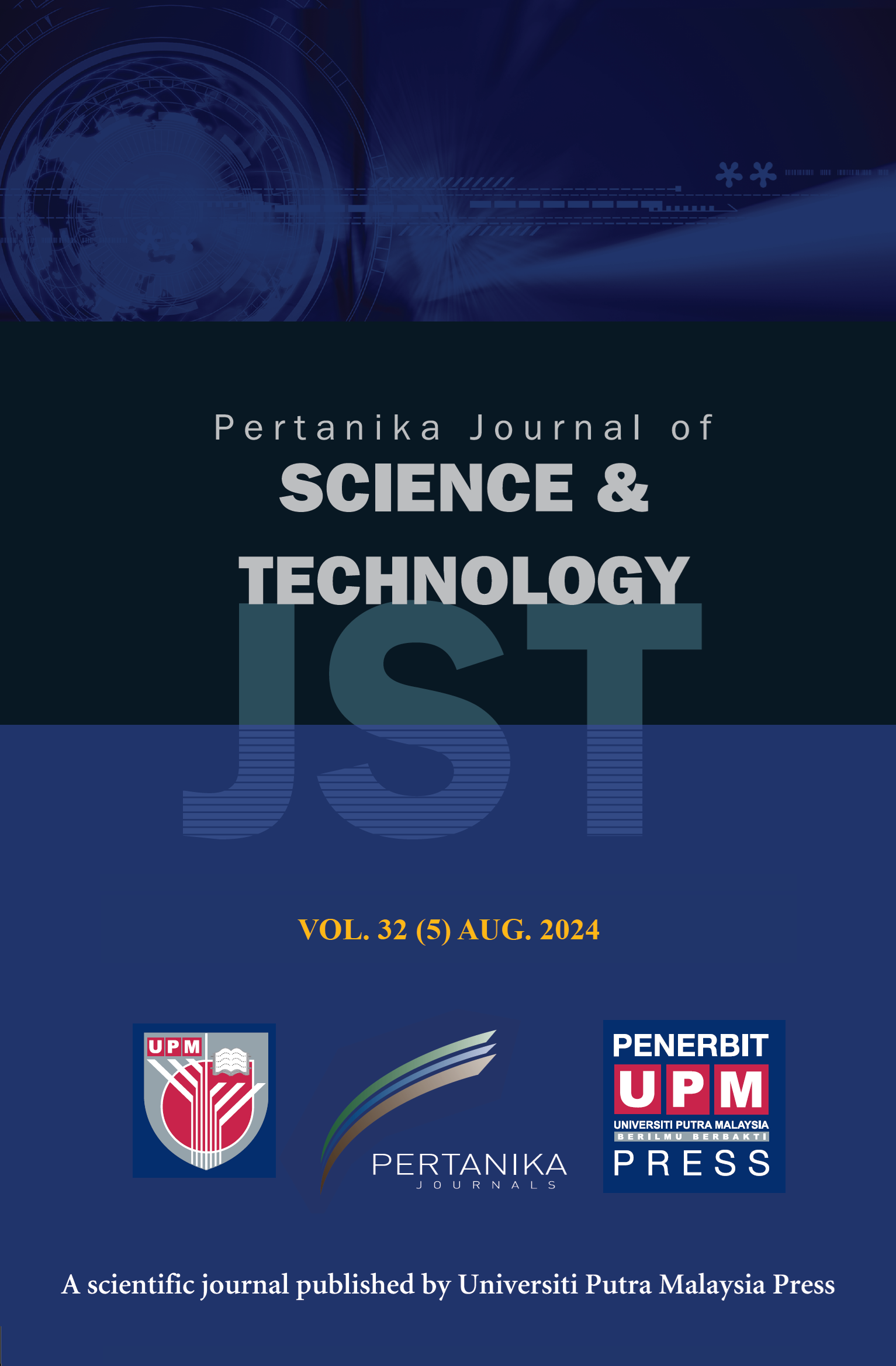PERTANIKA JOURNAL OF SCIENCE AND TECHNOLOGY
e-ISSN 2231-8526
ISSN 0128-7680
J
J
Pertanika Journal of Science & Technology, Volume J, Issue J, January J
Keywords: J
Published on: J
J
-
Ahmed, F. (2015). Induction of carotenoid and phytosterol accumulation in microalgae [Doctoral thesis, University of Queensland]. UQ eSpace. https://doi.org/10.14264/uql.2015.808
Ali, H. E. A., Shanab, S. M. M., Abo-Aly, M., Shalaby, E., Eldermerdash, U., & Abdullah, M. A. (2014). Screening of microalgae for antioxidant activities, carotenoids and phenolic contents, Applied Mechanics and Materials, 625, 156–159. https://doi.org/10.4028/www.scientific.net/AMM.625.156
Alwi, I., Ismail, A., Hatta, S. K. M., Buyong, F., & Mohamad, N. (2015). Bark pH as a factor affecting the density of epiphytic terrestrial algae in Taman Wetland Putrajaya, Malaysia. Journal of Applied and Physical Sciences, 1(1), 13-18. https://doi.org/10.20474/-japs1.1.3
Alwi, I., Ismail, A., Hatta, S. K. M., Buyong, F., Jamil, N. M., Sidek, N. J., Wahab, N. A., & Ismail, A. (2015). Bark pH as a factor affecting number of algal density of epiphytic terrestrial algae in Putrajaya, Malaysia. Proceeding of Global Trends in Academic Research, 2, 362 –371.
Arbona, V., Flors., V., Jacas, J., García-Agustín, P., & Gόmez- Cadenas, A. (2003). Enzymatic and non-enzymatic antioxidant responses of Carrizo citrange, a salt-sensitive citrus rootstock, to different levels of salinity. Plant and Cell Physiology, 44(4), 388–394. https://doi.org/10.1093/pcp/pcg059
Azim N., H., Subki, A., & Yusof, Z., N. (2018) Abiotic stresses induce total phenolic, total flavonoid and antioxidant properties in Malaysian indigenous microalgae and cyanobacterium. Malaysian Journal of Microbiology, 14(1), 25-33. https://doi.org/10.21161/MJM.100317
Beauchamp, C., & Fridovich, I. (1971). Superoxide dismutase: Improve assays and an assay applicable to acrylamide gels. Analytical Biochemistry, 44(1), 276-287. https://doi.org/10.1016/0003-2697(71)90370-8
Chokshi, K., Pancha, I., Ghosh, A., & Mishra, S. (2017) Salinity induced oxidative stress alters the physiological responses and improves the biofuel potential of green microalgae Acutodesmus dimorphus. Bioresource Technology, 244, 1376-1383. https://doi.org/10.1016/j.biortech.2017.05.003
Claiborne, A. L. (1985). Catalase activity. In R. A. Greenwald (Ed.), Handbook of method for oxygen radical research (pp. 283-284). CRC Press.
Danouche, M., Ghachtouli, N. E., Baouchi, A. E., &. Arroussi, H. E. (2020). Heavy metals phycoremediation using tolerant green microalgae: Enzymatic and non-enzymatic antioxidant systems for the management of oxidative stress. Journal of Environmental Chemical Engineering, 8(5), 1-11. https://doi.org/10.1016/j.jece.2020.104460
Darvehei, P., Bahri, P. A., & Moheimani, N. R. (2018). Model development for the growth of microalgae: A review. Renewable and Sustainable Energy Reviews, 97, 233–258. https://doi.org/10.1016/j.rser.2018.08.027
Gauthier, M. R., Senhorinho, G. N. A., & Scott, J. A. (2020) Microalgae under environmental stress as a source of antioxidants. Algal Research, 52, 1-10. https://doi.org/10.1016/j.algal.2020.102104
Hakiman, M., & Maziah, M. (2009). Non enzymatic and enzymatic antioxidant activities in aqueous extract of different Ficus deltoidea accessions. Journal of Medicinal Plants Research, 3(3), 120–131.
Hawksworth, D. L. (2020). Books on biodiversity and conservation. Biodiversity Conversation, 29, 3843-3862. https://doi.org/10.1007/s10531-020-02054-x
Hodges, D. M., Andrews, C. J., Johnson, D. A., & Hamilton, R. I. (1996). Antioxidant compound responses to chilling stress in differentially sensitive inbred maize lines. Physiologia Plantarum, 98(4), 685-692. https://doi.org/10.1034/j.1399-3054.1996.980402.x
Hossain, N., Hasan, M. H., Mahlia, T. M. I., Shamsuddin, A. H., & Silitonga, A. S. (2020). Feasibility of microalgae as feedstock for alternative fuel in Malaysia: A review. Energy Strategy Reviews, 32, 100536. https://doi.org/10.1016/j.esr.2020.100536
Jagota, S., & Dani, H. (1982). A new colorimetric technique for the estimation of vitamin C using Folin phenol reagent. Analytical Biochemistry, 127(1), 178-182. https://doi.org/10.1016/0003-2697(82)90162-2
Kanno, C., & Yamauchi, K. (1997). Application of a new iron reagent, 3-(2-Pyridyl)-5,6-diphenyl-1,2,4-triazine, to spectrophotometric determination of tocopherols. Agricultural and Biological Chemistry, 41(3), 593-596. https://doi.org/10.1080/00021369.1977.10862541
Kanz, T., & Bold, H. C. (1969). Physiological studies, morphological and taxonomical investigation of Nostoc and Anabaena in culture. University of Texas Press.
Kumar, R. R., Rao, P. H., Subramanian, V. V., & Sivasubranian. (2014) Enzymatic and non-enzymatic antioxidant potentials of Chlorella vulgaris grown in effluent of a confectionery industry. Journal of Food Science and Technology, 51, 322–328. https://doi.org/10.1007/s13197-011-0501-2
Le, Q. D., Haron, N. A., Tanaka, K., Ishida, A., Sano, Y., Dung, L. V., & Shirai, K. (2017). Quantitative contribution of primary food sources for a mangrove food web in Setiu lagoon from East coast of Peninsular Malaysia, stable isotopic (δ13C and δ15N) approach. Regional Studies in Marine Science, 9, 174-179. https://doi.org/10.1016/j.rsma.2016.12.013
Lichtenthaler, H. K. (1987). Chlorophylls and carotenoids: Pigments of photosynthetic biomembranes. Methods in enzymology, 146, 350-382. https://doi.org/10.1016/0076-6879(87)48036-1
Lietz, G., Oxley, A., Boesch-Saadatmandi, C., & Kobayashi, D. (2012). Importance of β,β-carotene15,15’-monooxygenase 1 (BCMO1) and β,β-carotene 9’,10’-dioxygenase 2 (BCDO2) in nutrition and health. Molecular Nutrition and Food Research, 56(2), 241-250. https://doi.org/10.1002/mnfr.201100387
Nakano, Y., & Asada, K. (1981). Hydrogen peroxide is scavenged by ascorbate-specific peroxidase in spinach chloroplasts. Plant and Cell Physiology, 22(5), 867-880. https://doi.org/10.1093/oxfordjournals.pcp.a076232
Noor, N. M., Anton, A., & Amin, N. M. (2007). Biodiversity of dinoflagellates in the coastal waters off Malacca, Peninsular Malaysia. Borneo Science, 21(1), 12-18.
Ogbonna, J. C. (2009). Microbiological production of tocopherols: Current state and prospects. Applied Microbiology and Biotechnology, 84, 217- 225. https://doi.org/101007/s00253-009-2104-7 Poot-Delgado, C. A., & Pkplodkov, Y. B. (2016). Microalgae as water quality indicators: An overview. Nova Science Publishers.
Price, A. H., Taylor, A., Ripley, S. J., Griffiths, A., & Trewavas, A. J. (1994). Oxidative signals in tobacco increase cytosolic calsium. The Plant Cell, 6(9), 1301-1310. https://doi.org/10.2307/3869827
Xiao, X., Li, W., Jin, M., Zhang, L., Qin, L., & Geng, W. (2023). Responses and tolerance mechanisms of microalgae to heavy metal stress: A review. Marine Environmental Research, 183, 105805. https://doi.org/10.1016/j.marenvres.2022.105805
Zakaria, M. F., Haris, N., Abd Wahid, M. E., Katayama, T., & Jusoh, M. (2020). Isolation and Nile red screening of indigenous microalgae species Pahang lakes potential lipid source in aquaculture feed. Malaysian Applied Biology, 49(4), 149-156. https://doi.org/10.55230/mabjournal.v49i4.1606
ISSN 0128-7680
e-ISSN 2231-8526




